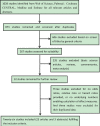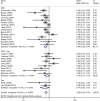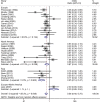Chemopreventive effects of 5-aminosalicylic acid on inflammatory bowel disease-associated colorectal cancer and dysplasia: a systematic review with meta-analysis
- PMID: 27906680
- PMCID: PMC5352032
- DOI: 10.18632/oncotarget.13715
Chemopreventive effects of 5-aminosalicylic acid on inflammatory bowel disease-associated colorectal cancer and dysplasia: a systematic review with meta-analysis
Abstract
Background and aims: The chemopreventive effect of 5-aminosalicylic acid (5-ASA) in patients with inflammatory bowel disease (IBD) has been widely studied; however, the results remain conflicting. The aim of this study was to systematically review the literature and update evidence concerning effects of 5-ASA on the risk of colorectal cancer (CRC) and dysplasia (Dys) in patients with ulcerative colitis (UC) or Crohn's disease (CD).
Results: 5-ASA showed a chemopreventive effect against CRC/Dys in IBD patients (OR = 0.58, 95% CI: 0.45-0.75). However, this effect was significant only in clinical-based studies (OR = 0.51; 95% CI: 0.39-0.65), but not in population-based studies (OR = 0.71; 95% CI: 0.46-1.09). Moreover, this effect was noticeable in patients with UC (OR = 0.46, 95% CI: 0.34-0.61), but not in CD (OR = 0.66, 95% CI: 0.42-1.03), and on the outcome of CRC (OR = 0.54, 95% CI: 0.39-0.74), but not Dys (OR = 0.47; 95% CI: 0.20-1.10). In IBD patients, mesalazine dosage ≥ 1.2 g/day showed greater protective effects against CRC/Dys than dosages < 1.2 g/day. However, Sulphasalazine therapy did not show any noticeable protective function regardless of the dosage administered.
Materials and methods: We performed a systematic review with a meta-analysis of 26 observational studies involving 15,460 subjects to evaluate the risks of developing CRC and Dys in IBD patients receiving 5-ASA treatment. Pooled odds ratios (ORs) and 95% confidence intervals (CIs) were calculated for each evaluation index.
Conclusions: 5-ASA has a chemopreventive effect on CRC (but not Dys) in IBD patients. Moreover, UC patients can benefit more from 5-ASA than CD patients. Mesalazine maintenance dosage ≥ 1.2 g/day is an effective treatment for reducing CRC risk in IBD patients.
Keywords: 5-Aminosalicylic acid; chemopreventive effect; colorectal cancer; dysplasia; inflammatory bowel disease.
Conflict of interest statement
The authors have declared that no competing interests exist.
Figures









References
-
- Canavan C, Abrams KR, Mayberry J. Meta-analysis: colorectal and small bowel cancer risk in patients with Crohn's disease. Aliment Pharmacol Ther. 2006;23:1097–1104. - PubMed
Publication types
MeSH terms
Substances
LinkOut - more resources
Full Text Sources
Other Literature Sources
Medical

